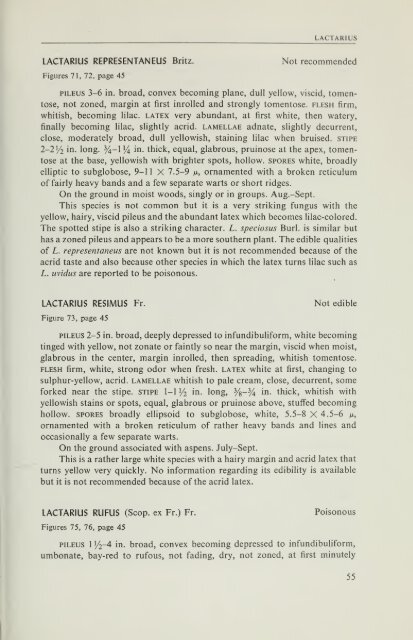You also want an ePaper? Increase the reach of your titles
YUMPU automatically turns print PDFs into web optimized ePapers that Google loves.
LACTARIUS<br />
LACTARIUS REPRESENTANEUS Britz. Not recommended<br />
Figures 71, 72, page 45<br />
PILEUS 3-6 in. broad, convex becoming plane, dull yellow, viscid, tomen-<br />
tose, not zoned, margin at first inrolled and strongly tomentose. flesh firm,<br />
whitish, becoming HIac. latex very abundant, at first white, then watery,<br />
finally becoming lilac, slightly acrid, lamellae adnate, sHghtly decurrent,<br />
close, moderately broad, dull yellowish, staining lilac when bruised, stipe<br />
2-2 Vi in. long. %-l )4<br />
in. thick, equal, glabrous, pruinose at the apex, tomen-<br />
tose at the base, yellowish with brighter spots, hollow, spores white, broadly<br />
eUiptic to subglobose, 9-11 X 7.5-9 /x, ornamented with a broken reticulum<br />
of fairly heavy bands and a few separate warts or short ridges.<br />
On the ground in moist woods, singly or in groups. Aug.-Sept.<br />
This species is not common but it is a very striking fungus with the<br />
yellow, hairy, viscid pileus and the abundant latex which becomes hlac-colored.<br />
The spotted stipe is also a striking character. L. speciosus Burl, is similar but<br />
has a zoned pileus and appears to be a more southern plant. The edible qualities<br />
of L. representaneus are not known but it is not recommended because of the<br />
acrid taste and also because other species in which the latex turns hlac such as<br />
L. uvidus are reported to be poisonous.<br />
LACTARIUS RESIMUS Fr. Not edible<br />
Figure 73, page 45<br />
PILEUS 2-5 in. broad, deeply depressed to infundibuliform, white becoming<br />
tinged with yellow, not zonate or faintly so near the margin, viscid when moist,<br />
glabrous in the center, margin inrolled, then spreading, whitish tomentose.<br />
FLESH firm, white, strong odor when fresh, latex white at first, changing to<br />
sulphur-yellow, acrid, lamellae whitish to pale cream, close, decurrent, some<br />
forked near the stipe, stipe 1-1 )/2 in. long, Y%-Y^<br />
in. thick, whitish with<br />
yellowish stains or spots, equal, glabrous or pruinose above, stuff'ed becoming<br />
hollow. SPORES broadly ellipsoid to subglobose, white, 5.5-8 X 4.5-6 ju?<br />
ornamented with a broken reticulum of rather heavy bands and lines and<br />
occasionally a few separate warts.<br />
On the ground associated with aspens. July-Sept.<br />
This is a rather large white species with a hairy margin and acrid latex that<br />
turns yellow very quickly. No information regarding its edibihty is available<br />
but it is not recommended because of the acrid latex.<br />
LACTARIUS RUFUS (Scop, ex Fr.) Fr.<br />
Figures 75, 76, page 45<br />
Poisonous<br />
PILEUS 1 )/^-4 in. broad, convex becoming depressed to infundibuhform,<br />
umbonate, bay-red to rufous, not fading, dry, not zoned, at first minutely<br />
55

















